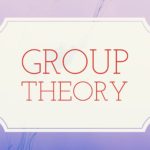The Center of the Heisenberg Group Over a Field $F$ is Isomorphic to the Additive Group $F$

Problem 283
Let $F$ be a field and let
\[H(F)=\left\{\, \begin{bmatrix}
1 & a & b \\
0 &1 &c \\
0 & 0 & 1
\end{bmatrix} \quad \middle| \quad \text{ for any} a,b,c\in F\, \right\}\]
be the Heisenberg group over $F$.
(The group operation of the Heisenberg group is matrix multiplication.)
Determine which matrices lie in the center of $H(F)$ and prove that the center $Z\big(H(F)\big)$ is isomorphic to the additive group $F$.
Sponsored Links
Proof.
Suppose that the matrix
\[M=\begin{bmatrix}
1 & x & y \\
0 &1 &z \\
0 & 0 & 1
\end{bmatrix}\]
is in the center of the Heisenberg group $H(F)$.
Let
\[A=\begin{bmatrix}
1 & a & b \\
0 &1 &c \\
0 & 0 & 1
\end{bmatrix}\]
be an arbitrary element in $H(F)$.
Since $M$ is in the center, we have $AM=MA$, that is,
\[\begin{bmatrix}
1 & a & b \\
0 &1 &c \\
0 & 0 & 1
\end{bmatrix}
\begin{bmatrix}
1 & x & y \\
0 &1 &z \\
0 & 0 & 1
\end{bmatrix} =\begin{bmatrix}
1 & x & y \\
0 &1 &z \\
0 & 0 & 1
\end{bmatrix}\begin{bmatrix}
1 & a & b \\
0 &1 &c \\
0 & 0 & 1
\end{bmatrix}.\]
Computing the products, we obtain
\[ \begin{bmatrix}
1 & x+a & y+az+b \\
0 &1 &z+c \\
0 & 0 & 1
\end{bmatrix}=\begin{bmatrix}
1 & a+x & b+cx+y \\
0 &1 &c+z \\
0 & 0 & 1
\end{bmatrix}.\]
Comparing $(1,3)$-entries, we have
\[az=cx.\]
This equality must be true for any $a, c \in F$.
We claim that $x=z=0$.
Taking $a=0, c=1$ (Note that since $F$ is a field, $0, 1 \in F$),
we have $x=0$. Also if $a=1, c=0$, then we have $z=0$.
Thus $x=z=0$ and the matrix $M$ becomes
\[M=\begin{bmatrix}
1 & 0 & y \\
0 &1 &0 \\
0 & 0 & 1
\end{bmatrix}.\]
It is clear from the computation of $AM=MA$ that this matrix is in the center for any $y$.
Therefore we have determined the center of the Heisenberg group:
\[Z\big(H(F)\big)=\left\{\, \begin{bmatrix}
1 & 0 & y \\
0 &1 &0 \\
0 & 0 & 1
\end{bmatrix} \quad \middle| \quad \text{ for any } y\in F \, \right \}.\]
To prove that the center $Z\big(H(F)\big)$ is isomorphic to the additive group $F$, consider the map
\[\phi: Z\big(H(F)\big) \to F\] which sends
\[M=\begin{bmatrix}
1 & 0 & y \\
0 &1 & 0 \\
0 & 0 & 1
\end{bmatrix} \in Z\big(H(F)\big)\]
to $y\in F$.
We prove that the map $\phi$ is a group isomorphism.
Let
\[M=\begin{bmatrix}
1 & 0 & y \\
0 &1 & 0 \\
0 & 0 & 1
\end{bmatrix}, M’=\begin{bmatrix}
1 & 0 & y’ \\
0 &1 & 0 \\
0 & 0 & 1
\end{bmatrix}\]
be any two elements in the center $Z\big(H(F)\big)$.
Then we have
\[MM’=\begin{bmatrix}
1 & 0 & y+y’ \\
0 &1 & 0 \\
0 & 0 & 0
\end{bmatrix}.\]
Therefore we have
\[\phi(MM’)=y+y’=\phi(M)+\phi(M’).\]
Thus, $\phi$ is a group homomorphism.
From the definition of $\phi$, it is easy to see that the homomorphism $\phi$ is injective and surjective, and hence $\phi$ is a group isomorphism.
Therefore, the center $Z\big(H(F)\big)$ of the Heisenberg group is isomorphic to the additive group of $F$.
Related Question.
The inverse element of the matrix
\[\begin{bmatrix}
1 & x & y \\
0 &1 &z \\
0 & 0 & 1
\end{bmatrix}\]
is given by
\[\begin{bmatrix}
1 & -x & xz-y \\
0 & 1 & -z \\
0 & 0 & 1
\end{bmatrix}.\]
For a proof, see the post The inverse matrix of an upper triangular matrix with variables.
 Add to solve later
Add to solve later
Sponsored Links












